| Reviews & Columns |
|
Reviews DVD TV on DVD Blu-ray 4K UHD International DVDs In Theaters Reviews by Studio Video Games Features Collector Series DVDs Easter Egg Database Interviews DVD Talk Radio Feature Articles Columns Anime Talk DVD Savant Horror DVDs The M.O.D. Squad Art House HD Talk Silent DVD
|
DVD Talk Forum |
|
|
| Resources |
|
DVD Price Search Customer Service #'s RCE Info Links |
|
Columns
|
|
|
Life and Death of Colonel Blimp: The Criterion Collection, The
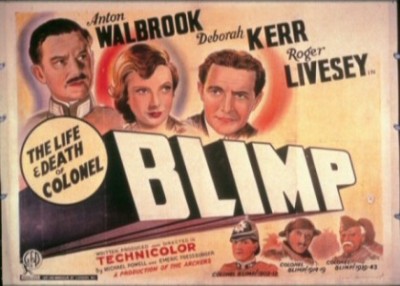
Please Note: The images used here are taken from stills provided by The Criterion Collection and promotional materials, not the Blu-ray edition of the film under review.
For those who know of the character's origins, Michael Powell and Emeric Pressburger's "Colonel Blimp" -- played by Roger Livesey, with shape-shifting prowess, from a young, cocky man to an old, left-behind one -- is "Colonel Blimp" in name only. The comically proper, perspective-lacking Englishman from whom the 1943 The Life and Death of Colonel Blimp gets its name, who only develops more clueless and blowhard-ish tendencies the older he gets, is based on a satirical character from newspaper comics by English political cartoonist David Low, but Powell and Pressburger's Blimp (or Clive Wynne-Candy, the name they give him) is only in small part a figure of fun, and the film is not really a satire at all. Via Pressburger's writing and the amazing execution of Powell/cast/crew, the physically quite fleshy colonel (thus the "Blimp") is also metaphorically fleshed out, and to an extraordinary extent, so that there is a whole lifetime, a whole background, and a whole progression of not-quite-brilliant career and vaguely unfulfilled personal experience to plumb underneath the iceberg tip of that comically huffing and puffing gentleman with his upper-crust delusions. The film that resulted from Powell and Pressburger's fine, remarkable efforts (which was finally brought to home video at its near three-hour length by Criterion in 1988 and has now undergone a superlative, definitive technical restoration by The Film Foundation and its partners) is fleet in its interwoven strands of comedy but more generally possessed of a warm, pragmatic sensibility, with a beautifully inventive, redolent, and fruitful structure that makes it the closest British rival to Citizen Kane, though its tone is much brighter and less acerbically debunking than Welles's great contribution.
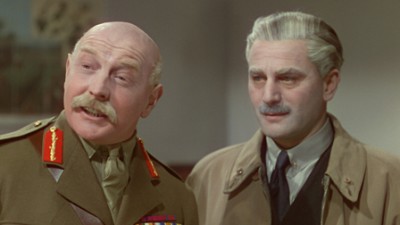
As in Kane, we begin at the ending: The colonel as we first see him in the WWII "present" is much as he appears two-dimensionally in Low's caricature: He's old, bald, and paunchy, his gut hanging precariously over his waist-towel as he lounges in an officer's-club Turkish bath in London and is taken by surprise in this vulnerable state when his "enemies" in upcoming war games jump the gun and show up early, since "real war" does not run on a schedule. His altercation with the rascally and arrogant young counterpart leading this unwelcome offensive lands them both in the club's pool and sets the film and us floating down memory lane, but already a defining trait, the split between Col. Wynne-Candy and the rest of the world, is foregrounded: The colonel is old-fashioned and traditional not only in the silly, stubborn, formality-enslaved, change-resisting "conservative" sense, but in a way that is much sweeter and righter than that, too, such that he cannot believe that any side in a war (or war games) would not adhere to the rules, that anyone would ever behave less than honorably or respectfully or humanely, despite any life-or-death, high-stakes disagreements, even ones that have resulted in war. An always-relevant point, not least to our own time and place, arises from the disconnect between the colonel's values and the "real world," when we encounter the middle-aged Col. Candy during World War I, denouncing, before a group of German prisoners of war, their side's interrogation tactics involving torture, and proclaiming his side, which he believes does not engage in such tactics, morally superior and thus assured of victory -- a true statement regarding the moral question and the Allies' ultimate victory, but one revealed as naïve when the colonel is gently taken away and a British soldier of South African origin (his own country a colonial victim of English violence during the Boer Wars) comes onto the scene and appears ready to do whatever it takes, morally acceptable or not, to get information from the prisoners.
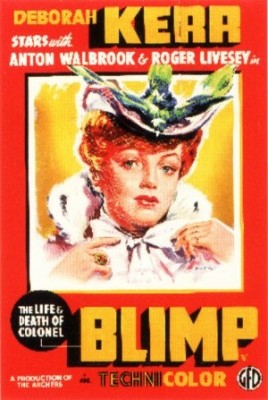
The respectable, upright, but sheltered colonel himself has only fond memories of those late-19th-century South African conflicts, though, and that moment at the birth of the 20th century is the story's true beginning, where the flashback takes us for the story's true start. Livesey, as the younger Clive Candy, appears as a chipper, smooth-faced lieutenant in the prime of his life, giddy and joking and confident fresh off of his army's South African victory, and heading off on a whim (against orders, in his own act of youthful trenchancy) to meet an English governess (Deborah Kerr) in Berlin who's complained to a colleague of Candy's about the German press's (not entirely unjustified) smearing of British behavior in South Africa. Once in Berlin, he flirts and verbally spars with this politically engaged, rambunctious, pre-bluestocking, and very pretty young woman, and is drawn into a duel when he breaches diplomacy by punching out a German double-agent he recognizes from the South African campaigns. This foolish duel, surrounded by empty pomp and ridiculous formalities, results in a lifelong friendship with his opponent, Theo Kretschmarr-Schuldorff (Anton Walbrook, so wonderfully memorable in his dapper handsomeness here, as he would be later for Powell and Pressburger again in The Red Shoes and in several films by Max Ophüls) after they non-fatally wound each other and meet up again in hospital, and an equally far-reaching sense of loss as he realizes too late, after the governess and Theo announce their engagement, that she was the love of his life. These are the three characters around whom Powell and Pressburger center the rest of the film, through its next two main movements: World War I and the more idyllic period between the wars culminating in the run-up to and involvement in World War II. Theo suffers as a prisoner of war, and under the world's punitive policy toward Germany in the wake of 1919, finally fleeing the Nazis back to England to become an officially mistrusted "enemy alien," but his friendship with Wynne-Candy, whom he comes to regard with forlorn protectiveness as someone whose innocence comes at least in part from ignorance of the kinds of hardship he, Theo, has seen, is indefatigable. Kerr reappears (and acquits herself very nicely; it seems impossible she was only 20 at the time) in two major roles -- that of Barbara Wynne, a nurse encountered by Candy (Wynne-Candy, after he "marries up" to her) in Flanders during the war, then sought out and proposed to on her aristocratic English estate after, for a blissful marriage ended prematurely, leaving Wynne-Candy a widower; and finally as Angela "Johnny" Cannon, Wynne-Candy's fresh-faced young driver driver/secretary in WWII (who happens to also be the girlfriend of the whippersnapper who confronts the colonel at the beginning of the film), who joins with Theo to soften the blow when the realization that his place in the English military has faded, along with his relevance to contemporary life at all, finally begins to dawn on the proud old man.
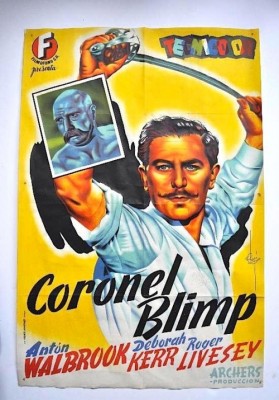
The film's flashback structure is only the most obvious of its always nimble and perceptive narrative strategies; much more daring and important are Powell and Pressburger's elisions of what in more ordinary films would be at least "events," and likely central ones. We never witness battle, for one thing (though we see plenty of its aftermath, and the lulls in between), and it's a breathtakingly audacious moment (both narratively and aesthetically) when, just as the duel between Theo and Wynne-Candy is about to begin after a long and detailed preparation, Powell's camera takes us up, out through a skylight and into a wide exterior shot, where we come down again to join the waiting, worried Kerr, to learn along with her the tragicomic results of the duel when we see an ambulance coming away from the gymnasium. Most of the film's unseen in-between, connecting, "eventful" information is conveyed through later descriptions, or montages of newspapers (more shades of Kane), or, most stylistically exciting, with sequences in which trophies from Wynne-Candy's leisure-time hunting expeditions suddenly pop, in staccato jump-cut edits, onto empty walls and begin to fill his bachelor's quarters in the home of his curmudgeonly Aunt Margaret (Muriel Aked). This might seem an apolitical film (it certainly has no banner-flying "messages") -- and, despite Winston Churchill's personal condemnation of their proposed film and the British military's refusal to participate in it, Powell and Pressburger themselves were hardly slouches in supporting the war effort -- but their values emerge in their bold, unconventional prioritizations of story elements, leaving a subtle, organic political dimension to the film through their interest in and emphasis on showing friendship, love, and civilian life and their minimization of the "excitement" of war.
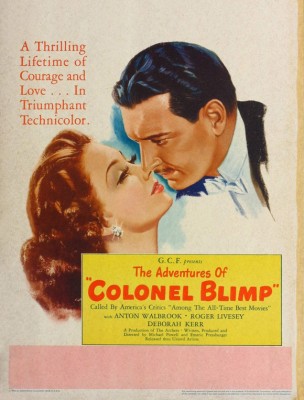
The film's use of style and technique -- its look, tone, tempo, and feel -- is equally distinctive to its alluring, rewarding, inventive narrative approach. Powell's framings and movements are unfailingly assured and successful in their intuition for what will best facilitate the richest storytelling and most fully elicited emotional response, whether he's giving us a burst of loud movement at the film's opening with a convoy of soldiers on motorbikes headed for the war games; offering up an explosion of fantastically coordinated color, figures, and choreographed movement of actors and camera in an extras-packed scene at a fancy Berlin restaurant; or simply (but sublimely) showing us a single, autumn-orange leaf floating on the surface of the urban mini-reservoir supply where Col. Wynne-Candy's residence used to be before a devastating London air raid. Colonel Blimp was the first of Powell and Pressburger's films to be shot in color (by Georges Périnal, whose storied career stretched back to Cocteau's Blood of a Poet and would progress to further delirious heights of color in Preminger's Bonjour Tristesse), aided here by longtime Powell/Pressburger lighting cameraman Jack Cardiff, the fine recent documentary about whom is a great place to start for further insights into the look of their work), but you'd never guess it from their masterful marshaling of Technicolor's inimitable palette. The use of color in the films of Powell and Pressburger is a subject worthy of a semester-long course at film school, and nothing I write here can adequately convey the sheer visual pleasure and narrative effectiveness of it, but I'll isolate two examples among what must number in the dozens of brilliant, perfectly justified and well-integrated flourishes of color in Blimp: In a preview of their conjoining of gorgeous matte work and studio-built sets/lighting for a clearly artificial mise-en-scène that would come to demonstrate, especially in the later Black Narcissus, a kind of power unavailable to direct-location shooting, the long, rain-soaked, muddy World War I sequence set in Flanders is an "exterior" that is in fact a studio creation, varying dark shades of brown, gray, and black to create a near-expressionistic "Flanders" that better conveys what it must have felt like to travel, fight, and recuperate in such endless dreariness. Powell and Périnal then top themselves when they bring us out of the war; England is still khaki and grey, but the return to color in the textile factories announced in one of those bridging newspaper-article close-ups is made to come alive for us as a young woman in one of said factories carries into the frame multicolored palates of thread against the grey shuttling in the factory background, signaling and symbolizing in one visually rapturous moment of transition an entire nation and culture's readiness to come out of the brown, bleak, muddy wartime in which the preceding scenes had immersed us.
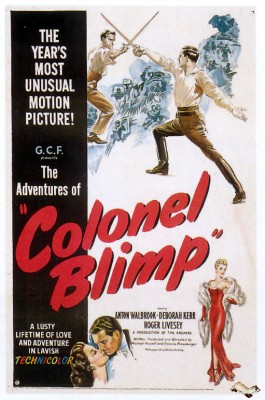
As Stephen Fry notes in one of the disc's supplements, The Life and Colonel Blimp is a rare, very happy marriage of two kinds of perfection: the visual/technical (Powell's forté), and that having to do with the narrative and the dialogue (Pressburger's half of the bargain). The crown-jewel performances of Livesey, Walbrook, and Kerr are ringed by a nonstop parade of impeccably cast character actors, and there is a never-ending feast of technical and stylistic resourcefulness on display, while in its overall tempo and organization, the film (seen as it is here in its full, intended version) literally never misses a beat, its diverse manifestations of liveliness and energy within every frame matched by an overall energy and creativity on the filmmakers' part to engage, surprise, and deeply touch us, making us forget ourselves for the entirety of the experience and leaving a nearly three-hour film of epic plot feeling like mere moments (you have to re-orient yourself when it's over, so completely does it immerse a viewer and make us forget our own immediate sense of time and place). It's a very specific and detailed story about an uncommon type of character from a particular era and society, yet the ebullience, originality, and acute insightfulness of Powell and Pressburger's conception and execution is such that the film seems to contain all the joy and sadness of life itself -- the pleasure of being alive in the world, the hope of youth and the participating and engaging with our fellow human beings; the inevitable disappointments and the ever-encroaching passing of time and ultimate fading away of all things, bad or good. It fits every meaningful definition of the word "classic," and its charms, which add up and cohere into something like perfection (or as close to perfection as the cinema, a complex medium the great works of which aren't necessarily great because they're "perfect," allows for), are always there, fresh and appealing and affecting as ever, when you return to it, as anyone who's ever had the pleasure of experiencing it will inevitably feel impelled to do.
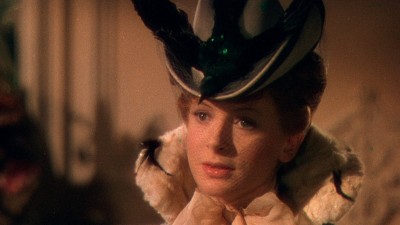
Video:
The new high-definition transfer of The Life and Death of Colonel Blimp used for this Blu-ray edition was a collaborative effort among several film-preservation entities (including The Film Foundation, a non-profit with a board of "filmmakers for film preservation" and Martin Scorsese as its public face), and it's stunning, something to be grateful for. Criterion presents the film (AVC/MPEG-4 encoded, 1080/24p-mastered at its original theatrical aspect ratio of 1.37:1) looking both pristine and fully cinematic, and there's bounteous, beautiful evidence on hand at every turn that the digital artisans responsible for achieving this delicate balance have done it the painstaking, thorough, conscientious way. A restoration demonstration included as a supplement (see below) confirms it, but you can see how near-flawless it is (there are, perhaps certain moments where some color fading/degradation was not able to be completely ameliorated, but these are rare) as you watch the film: The Technicolor is dazzlingly well-preserved, so rich and deep and solid at every point on the color spectrum (from the darkest, rainiest Flanders mud fields to the bright rainbow of a fancy Berlin café, and everything in between) that it's hard to believe they could pull it off without over-relying on digital noise reduction (DNR) and sacrificing the real-movie texture of the thing to make it "clean." But no, no babies were thrown out with the bathwater to make this Colonel Blimp Blu-ray such a joy to look at; it offers us a precious cinematic gem that's been polished up to look its very best, but with extreme caution taken not to scrub off any of its rare cinematic personality.
Sound:The uncompressed monaural PCM soundtrack is sparkling and sounds just like new circa 1943. While the technical limitations of the era are there (a certain distortion and tinniness to the more intense stretches of film's brassy score, which hardly distracts if you've ever seen a film of this or earlier vintage), the sound is overall glorious and near-perfect; neither the plash of falling rain nor the hubbub of a crowded restaurant nor, especially, the rumbling, hoarse, unforgettable voice of Roger Livesey's Colonel Blimp has ever sounded nearly as clear, deep, or full on home video as they do here.
Extras:New supplements on this latest Colonel Blimp release include:
--A 12-minute introduction to the film by Martin Scorsese, who has been a Powell revivalist/advocate for decades now (his Film Foundation is one of the major participants in this amazing new restoration). Scorsese, who here, as in his Personal Journey through American Film, looks into the camera and speaks earnestly and convincingly, like some movie-expert friend eager to share something exciting with you, draws on his extensive knowledge to give us a rundown on the film's production/release history and its subsequent longtime status as a lost item in the Powell/Pressburger filmography (until renewed interest gained momentum in the '80s, helped along even then by Scorsese's endorsements). He has personal anecdotes to share about introducing Robert de Nero to Powell (when the actor, preparing to play Jake LaMotta, grilled the bemused Powell about Roger Livesey's physical transformations to play Col. Wynne-Candy), and about first watching the film's truncated version in B&W on TV and falling in love with it even so. He goes into beautiful detail, both aesthetic and biographical, about why the film is important to him and should be to us, taking scintillating detours to show us a particular scene in Raging Bull that was directly shaped by Scorsese's deep love for The Life and Death of Colonel Blimp. In all, it's a treat (as one expects by now) to hear Scorsese express and explain his undying, intense devotion to a particularly beloved film.
--"Optimism and Sheer Will," a half-hour interview, conducted in New York by a French documentarian, with Powell's widow (and legendary film editor -- she's Scorsese's most frequent technical collaborator going all the way back to Who's That Knocking at My Door?) Thelma Schoonmaker, who's an immensely appealing interviewee, full of astute observations about the film as well as personal stories about her introduction to Powell and Pressburger (and then to Powell himself) through the enthusiasm of Martin Scorsese. Her demeanor and remembrances of herself, Powell, and Scorsese make their group seem like a trio of friends it would have been most enjoyable and enlightening to be part of.
--A 30-page booklet insert (much nicer than the fold-in thing that accompanied the old DVD version) richly and colorfully illustrated with film stills and featuring a new, warm and thoughtful appreciative essay on the film by critic Molly Haskell.
Additionally, all of the bonus material from Criterion's 2002 DVD edition (save for the booklet material, which has been replaced), has been kept on, including:
--A delightful audio commentary with Martin Scorsese and Powell himself makes its third appearance on Criterion disc (it was originally recorded in 1988, when Powell was still alive, for their laserdisc edition, retained for the 2002 DVD, and thankfully remains on the new edition). Scorsese expanding upon and going into great detail about his long and impassioned history with Colonel Blimp (his analyses of color and the rhythm of scenes is another rare moment, like the one having to do with Raging Bull in the new Scorsese introduction, where we can share in the process of the influence of one director's films on another), and Powell (turn up the volume a bit for his stretches; his age and his extra-plummy accent make him harder to understand than Scorsese) generously sharing out his personally remembered stories from the film's preparation, shooting, and reception, spanning everything from the most minute (yet fascinating) technical details to the biggest thematic observations to his and Emeric Pressburger's bemused fortitude in the face of official disapproval toward the film from the highest levels of British government.
--A 2000 documentary made for British TV, "A Profile of The Life and Death of Colonel Blimp (24 min.), featuring venerable film scholar Ian Christie; actor, director, writer, and Powell devotee Stephen Fry (Wilde); Powell's grandson Alexander McDonald (producer of Never Let Me Go and multiple others); and various members of the Blimp crew, including legendary cinematographer Jack Cardiff.
--Two stills galleries, one constituting a history in pictures of the "Colonel Blimp" character/caricature in David Low's cartoons, the other a gallery of behind-the-scenes stills from the film's production.
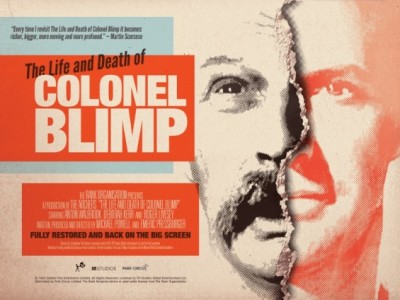
The new Blu-ray edition of Michael Powell and Emeric Pressburger's The Life and Death of Colonel Blimp doesn't just miraculously restore the visual beauty of this great film (perhaps as great, in its own very British way, as Citizen Kane); it also comes loaded with context that reminds us of its decades-long slog through the desert of severe, sloppy editing-down and messy, incomplete, technically deficient prints, reminding us how fortunate we are to have it at all, let alone in a version as complete and gorgeous as this. The film itself is, of course, a treasure -- the intimate-epic story of Colonel Wynne-Candy (the wonderful Roger Livesey), one representative scion of a stiff-upper-lipped, ultra-civil Englishness who ever more cluelessly (and touchingly) maintains those values through two World Wars that prove (or at least render) them obsolete, all while he pursues his Ideal Woman (Deborah Kerr, in three roles) and becomes unlikely, lifelong friends with the "enemy" in the form of his less-fortunate German opposite number (Anton Walbrook). This was Powell and Pressburger's first color film, and its supremely well-integrated and imaginative uses of Technicolor are such that it's hard to decide whether its look, the cleverness and affectionate humor around the principled but blowhard-ish Colonel, its surprise layers of deep emotional impact, or its brilliant structure (done not for show, but to most effectively bring out and develop the senses of melancholy and loss that come with the passing of time over a whole life) are its highest achievement. What is certain, though, is that whether you appreciate one of those qualities more on this viewing and another of its many accomplishments on the next, there will always be a happily anticipated next time watching it for as long as you're around to revisit the classic films in your collection (of which this Blu-ray is an essential part); The Life and Death of Colonel Blimp is a long-lived masterpiece whose riches at every level are well-nigh inexhaustible. DVD Talk Collector Series.
|
| Popular Reviews |
| Sponsored Links |
|
|
| Sponsored Links |
|
|
| Release List | Reviews | Shop | Newsletter | Forum | DVD Giveaways | Blu-Ray | Advertise |
|
Copyright 2024 DVDTalk.com All Rights Reserved. Legal Info, Privacy Policy, Terms of Use,
Manage Preferences,
Your Privacy Choices | |||||||













